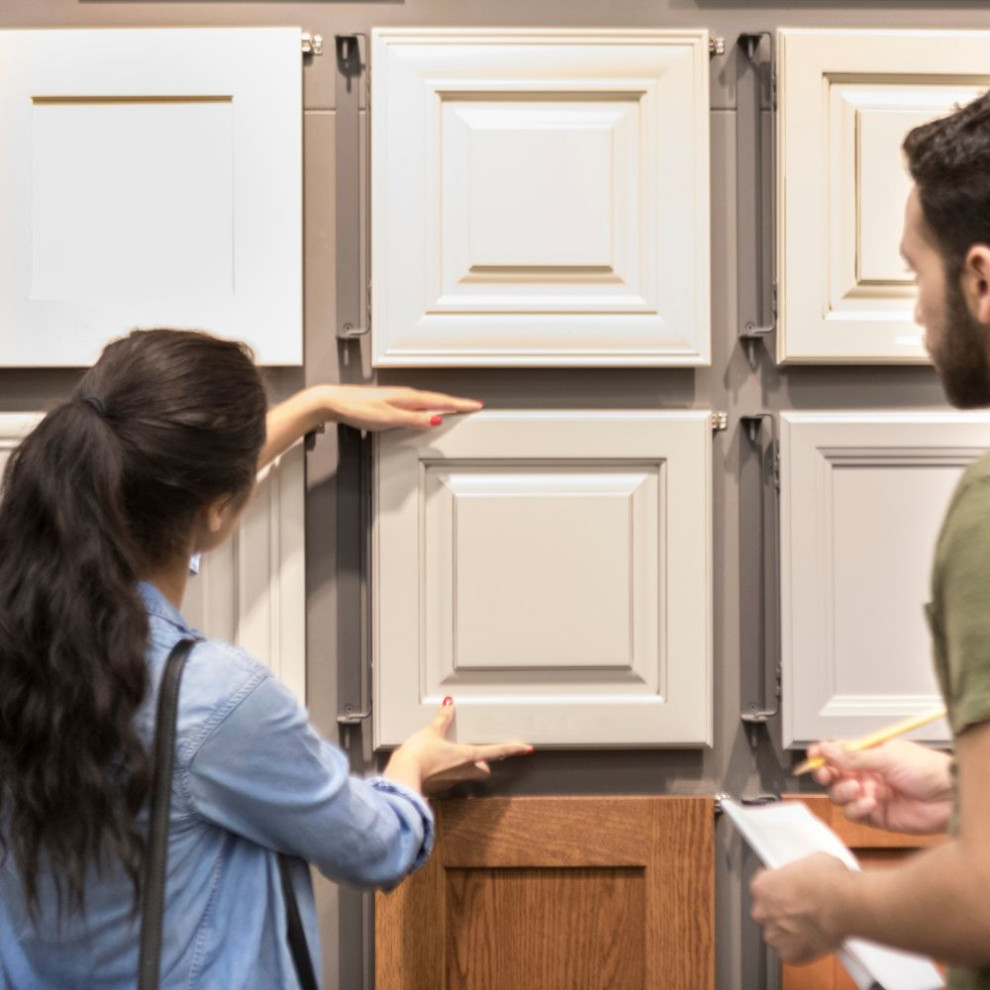New Builds, Remodels, & Additions: Call Us for a Home Transformation!
Request ConsultationA Guide to Selecting the Perfect Cabinetry for Your Home

Introduction
Today we take a deep dive into the world of cabinetry. Whether you're planning a kitchen remodel, dreaming up a new bathroom vanity, or simply have a passion for exceptional craftsmanship, you'll find a wealth of knowledge here. From the latest trends in design and materials to practical tips for choosing and maintaining your cabinets, we cover it all. Join us as we delve deep into the heart of cabinetry, exploring its essential role in enhancing both the beauty and practicality of our living spaces.
Types of Cabinetry
- Shaker: Characterized by a five-piece door with a recessed center panel. Simple, clean lines make it versatile for traditional or modern styles.
- Flat-Panel or Slab: Offers a minimalist, sleek look with no frills or detailing, ideal for contemporary or modern interiors.
- Inset: The door is set inside the cabinet frame, offering a precise, clean look, but can be more expensive due to the precision required.
- Distressed: Ideal for a rustic or antique look. The wood is artificially aged or distressed.
- Beadboard: Features vertical slats, giving a more dynamic texture. Great for cottage-style or country aesthetics.
- Louvered: Has horizontal wooden slats, often seen on windows and furniture pieces. Provides a distinctive architectural style.
- Thermofoil: Made from medium-density fiberboard (MDF) covered with a plastic coating and heated to mold it into shape. Affordable and offering a variety of styles.
Finishes for Cabinetry
- Natural Wood Finish: Showcases the natural beauty and grain of the wood. Can be found in various wood types like oak, cherry, or maple.
- Stained: Enhances the wood's natural color and grain pattern. Available in a wide range of shades from light to dark.
- Painted: Provides a smooth, consistent color. Popular colors include white, gray, and blue, but can be done in any color.
- Glazed: Adds depth and color to the cabinet surface. The glaze is applied over paint or stain, then wiped off by hand.
- Thermofoil: A plastic coating applied to engineered wood, available in a variety of colors and patterns, including imitation wood.
- Laminate: Made from layers of paper and plastic resin, laminate cabinets are durable and come in a wide range of colors and patterns.
- Polyurethane Finish: Provides a protective coating over the wood, enhancing durability and giving a sleek, polished look.
- Brushed Finish: Creates a slightly textured look, often used with metallic paints for a more industrial or contemporary feel.
Types of Wood
Cherry Wood
- Appearance: Rich, warm tones with a smooth grain pattern. Colors can range from light blond to deep brown.
- Durability: Moderately hard, resists warping and shrinking well.
- Ideal For: Elegant, timeless cabinetry often used in traditional or formal settings.
Maple Wood
- Appearance: Light, creamy color with a subtle grain pattern. Can be stained to mimic more expensive woods.
- Durability: Hard and sturdy, with good resistance to wear and tear.
- Ideal For: Versatile use, suitable for both contemporary and traditional styles.
Oak Wood
- Appearance: Prominent grain pattern with a range of colors from white to pink and reddish tones.
- Durability: Very strong and heavy, excellent for long-lasting cabinetry.
- Ideal For: Rustic or country-style kitchens, also works well for a classic look.
Hickory Wood
- Appearance: Striking grain patterns with considerable color variation, from white to dark brown.
- Durability: Extremely hard and strong.
- Ideal For: Rustic or farmhouse-style kitchens, offers a rugged, natural look.
Walnut Wood
- Appearance: Rich, dark brown color with a fine, straight grain. Considered a premium hardwood.
- Durability: Strong, but slightly softer than oak or hickory.
- Ideal For: High-end, luxurious cabinetry designs.
Birch Wood
- Appearance: Light yellow to creamy white color, often mistaken for maple. Fine, smooth grain.
- Durability: Hard and strong, but more prone to warping than other woods.
- Ideal For: Affordable yet stylish cabinetry, suitable for a variety of finishes.
Alder Wood
- Appearance: Light brown with a subtle grain, often used as a cherry or maple substitute.
- Durability: Softer than cherry or maple, but still durable enough for cabinetry.
- Ideal For: A budget-friendly alternative for achieving a high-end look.
Pine Wood
- Appearance: Light color with visible knots, offering a distinctive, rustic charm.
- Durability: Softer and more prone to dents and scratches.
- Ideal For: Cottage or country-style kitchens, popular in rustic designs.
Poplar Wood
- Appearance: Generally pale with a yellowish or whitish hue, Poplar has a straight, uniform grain. It's known for its lack of distinct pattern, offering a smooth and clean look.
- Durability: Poplar is softer than many hardwoods like oak or maple, but it's still relatively durable. It's not as resistant to dents and scratches compared to harder woods.
- Ideal For: Painted Cabinetry. Its smooth grain makes it an excellent choice for painting, as it results in a clean, crisp finish without the grain showing through.
To much? Call us to help assist you in selecting your next cabinetry chooses.
We understand the importance of selecting the right wood type for your custom cabinetry, as each variety brings its unique qualities, styles, and finishes. When choosing the perfect wood for your cabinets, it's crucial to consider the overall style of your home, the specific aesthetic you desire for your cabinetry, and the usual usage and traffic in the area where the cabinets will be installed. We are here to assist you in making these important decisions and to answer any questions you may have. Feel free to reach out to us at HoneyB Construction for further guidance or inquiries – we’re dedicated to helping you create the perfect space with the ideal cabinetry that suits all your needs.
